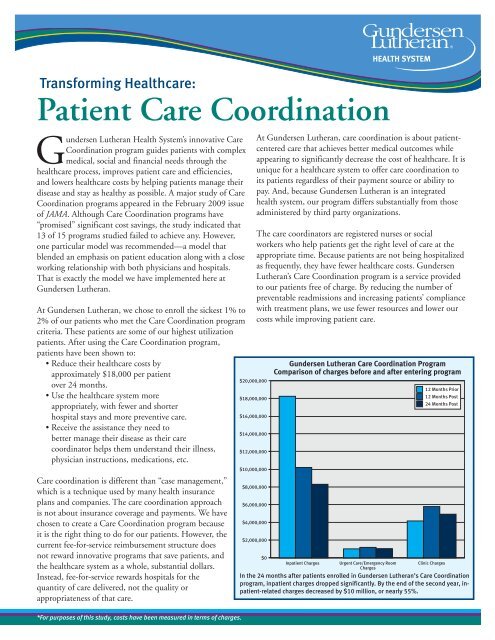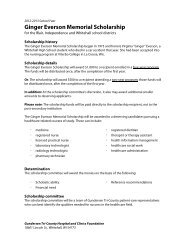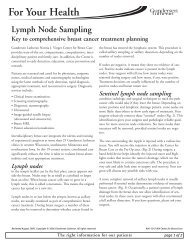Patient Care Coordination - Gundersen Lutheran Health System
Patient Care Coordination - Gundersen Lutheran Health System
Patient Care Coordination - Gundersen Lutheran Health System
Create successful ePaper yourself
Turn your PDF publications into a flip-book with our unique Google optimized e-Paper software.
Transforming <strong>Health</strong>care:<br />
<strong>Patient</strong> <strong>Care</strong> <strong>Coordination</strong><br />
<strong>Gundersen</strong> <strong>Lutheran</strong> <strong>Health</strong> <strong>System</strong>’s innovative <strong>Care</strong><br />
<strong>Coordination</strong> program guides patients with complex<br />
medical, social and financial needs through the<br />
healthcare process, improves patient care and efficiencies,<br />
and lowers healthcare costs by helping patients manage their<br />
disease and stay as healthy as possible. A major study of <strong>Care</strong><br />
<strong>Coordination</strong> programs appeared in the February 2009 issue<br />
of JAMA. Although <strong>Care</strong> <strong>Coordination</strong> programs have<br />
“promised” significant cost savings, the study indicated that<br />
13 of 15 programs studied failed to achieve any. However,<br />
one particular model was recommended—a model that<br />
blended an emphasis on patient education along with a close<br />
working relationship with both physicians and hospitals.<br />
That is exactly the model we have implemented here at<br />
<strong>Gundersen</strong> <strong>Lutheran</strong>.<br />
At <strong>Gundersen</strong> <strong>Lutheran</strong>, we chose to enroll the sickest 1% to<br />
2% of our patients who met the <strong>Care</strong> <strong>Coordination</strong> program<br />
criteria. These patients are some of our highest utilization<br />
patients. After using the <strong>Care</strong> <strong>Coordination</strong> program,<br />
patients have been shown to:<br />
• Reduce their healthcare costs by<br />
approximately $18,000 per patient<br />
over 24 months.<br />
• Use the healthcare system more<br />
appropriately, with fewer and shorter<br />
hospital stays and more preventive care.<br />
• Receive the assistance they need to<br />
better manage their disease as their care<br />
coordinator helps them understand their illness,<br />
physician instructions, medications, etc.<br />
<strong>Care</strong> coordination is different than “case management,”<br />
which is a technique used by many health insurance<br />
plans and companies. The care coordination approach<br />
is not about insurance coverage and payments. We have<br />
chosen to create a <strong>Care</strong> <strong>Coordination</strong> program because<br />
it is the right thing to do for our patients. However, the<br />
current fee-for-service reimbursement structure does<br />
not reward innovative programs that save patients, and<br />
the healthcare system as a whole, substantial dollars.<br />
Instead, fee-for-service rewards hospitals for the<br />
quantity of care delivered, not the quality or<br />
appropriateness of that care.<br />
*For purposes of this study, costs have been measured in terms of charges.<br />
$20,000,000<br />
$18,000,000<br />
$16,000,000<br />
$14,000,000<br />
$12,000,000<br />
$10,000,000<br />
$8,000,000<br />
$6,000,000<br />
$4,000,000<br />
$2,000,000<br />
At <strong>Gundersen</strong> <strong>Lutheran</strong>, care coordination is about patientcentered<br />
care that achieves better medical outcomes while<br />
appearing to significantly decrease the cost of healthcare. It is<br />
unique for a healthcare system to offer care coordination to<br />
its patients regardless of their payment source or ability to<br />
pay. And, because <strong>Gundersen</strong> <strong>Lutheran</strong> is an integrated<br />
health system, our program differs substantially from those<br />
administered by third party organizations.<br />
The care coordinators are registered nurses or social<br />
workers who help patients get the right level of care at the<br />
appropriate time. Because patients are not being hospitalized<br />
as frequently, they have fewer healthcare costs. <strong>Gundersen</strong><br />
<strong>Lutheran</strong>’s <strong>Care</strong> <strong>Coordination</strong> program is a service provided<br />
to our patients free of charge. By reducing the number of<br />
preventable readmissions and increasing patients’ compliance<br />
with treatment plans, we use fewer resources and lower our<br />
costs while improving patient care.<br />
$0<br />
<strong>Gundersen</strong> <strong>Lutheran</strong> <strong>Care</strong> <strong>Coordination</strong> Program<br />
Comparison of charges before and after entering program<br />
Inpatient Charges Urgent <strong>Care</strong>/Emergency Room<br />
Charges<br />
12 Months Prior<br />
12 Months Post<br />
24 Months Post<br />
12 Months Prior<br />
12 Months Post<br />
24 Months Post<br />
Clinic Charges<br />
In the 24 months after patients enrolled in <strong>Gundersen</strong> <strong>Lutheran</strong>’s <strong>Care</strong> <strong>Coordination</strong><br />
program, inpatient charges dropped significantly. By the end of the second year, inpatient-related<br />
charges decreased by $10 million, or nearly 55%.
Reducing healthcare costs<br />
Based on our initial analysis, <strong>Gundersen</strong> <strong>Lutheran</strong>’s <strong>Care</strong><br />
<strong>Coordination</strong> program appears to significantly reduce<br />
healthcare costs for patients enrolled in the program. The<br />
savings result from patients using the healthcare system<br />
more appropriately.<br />
For example, <strong>Gundersen</strong> <strong>Lutheran</strong> tracked healthcare<br />
utilization and costs for the 530 patients who enrolled<br />
in the program between 2005 and 2008 and who<br />
continued with the program for 24 months. This initial<br />
analysis compared the utilization and costs for the 12<br />
months prior to enrollment to the 12 and 24 month<br />
periods after the patients entered the program. The<br />
analysis showed a decrease of about $6.5 million in total<br />
charges for this group of patients after 12 months and an<br />
additional $3 million decrease after 24 months. Clinic<br />
(ambulatory care) visits went up as patients shifted from<br />
inpatient care areas to ambulatory care. As patients began<br />
to better manage their disease, costs also shifted from the<br />
more expensive inpatient care areas to ambulatory care. By<br />
the end of the second year, inpatient-related charges dropped<br />
by 55% and overall charges decreased 40%.<br />
At <strong>Gundersen</strong> <strong>Lutheran</strong> it cost us an average of $2,000 a year<br />
to coordinate the care of a patient in the program between<br />
2005 and 2009. After 12 months in the program, charges<br />
decreased an average of $15,000 per patient.<br />
$30,000,000<br />
$25,000,000<br />
$20,000,000<br />
$15,000,000<br />
$10,000,000<br />
$5,000,000<br />
$0<br />
<strong>Gundersen</strong> <strong>Lutheran</strong> <strong>Care</strong> <strong>Coordination</strong> Program<br />
Comparison of charges before and after entering program<br />
Total Charges<br />
Program results<br />
<strong>Gundersen</strong> <strong>Lutheran</strong>’s data for the 530 patients who<br />
enrolled in our program between 2005 and 2008 and<br />
used <strong>Care</strong> <strong>Coordination</strong> for 24 months shows:*<br />
• Almost 80% of all charges for patients before they<br />
enrolled in <strong>Care</strong> <strong>Coordination</strong> were inpatient-related<br />
charges<br />
• After being enrolled for two years, inpatient-related<br />
charges dropped by $10 million, or almost 55%<br />
• With the shift from high-cost hospitalizations to<br />
lower-cost clinic care, total charges dropped by 40%<br />
• For every dollar <strong>Gundersen</strong> <strong>Lutheran</strong> invests in the <strong>Care</strong><br />
<strong>Coordination</strong> program, we are reducing healthcare<br />
charges for these patients by approximately $8<br />
<strong>Gundersen</strong> <strong>Lutheran</strong>’s early results are very promising<br />
and warrant further research into the benefits of <strong>Care</strong><br />
<strong>Coordination</strong>.<br />
The future of <strong>Care</strong><br />
<strong>Coordination</strong><br />
<strong>Care</strong> <strong>Coordination</strong> is extremely promising as a program that<br />
could significantly reduce healthcare costs for the sickest 1%<br />
to 2% of patients at <strong>Gundersen</strong> <strong>Lutheran</strong>. However, there<br />
are another 2% to 5% of patients who are moderately sick<br />
and use a significant amount of healthcare resources. This is<br />
a population of patients that the <strong>Care</strong> <strong>Coordination</strong> program<br />
can be expanded to help in the future, with the potential of<br />
reducing healthcare charges by millions of dollars a year at<br />
<strong>Gundersen</strong> <strong>Lutheran</strong> alone.<br />
12 Months Prior<br />
12 Months Post<br />
24 Months Post<br />
An analysis of <strong>Gundersen</strong> <strong>Lutheran</strong>’s <strong>Care</strong> <strong>Coordination</strong> program showed a nearly $9.5 million<br />
decrease (40%) in total charges for the 530 patients who enrolled in the program and used <strong>Care</strong><br />
<strong>Coordination</strong> for 24 months. After 24 months in the program, charges decreased an average of<br />
almost $18,000 per patient.<br />
*Charges for the year prior to activation<br />
compared to the charges for 24 months<br />
following activation
Establishing <strong>Care</strong> <strong>Coordination</strong><br />
<strong>Patient</strong>s enter <strong>Gundersen</strong> <strong>Lutheran</strong>’s <strong>Care</strong> <strong>Coordination</strong><br />
program if they are shown to:<br />
• have had frequent hospitalizations, Emergency Room<br />
or Urgent <strong>Care</strong> visits, or falls or are on multiple<br />
medications;<br />
• have multiple healthcare providers or chronic health<br />
conditions;<br />
• lack a strong support system at home to help them<br />
navigate the healthcare system; and/or<br />
• are having difficulty coping with the complexity of<br />
their healthcare needs.<br />
<strong>Patient</strong>s are identified for possible enrollment in the<br />
<strong>Care</strong> <strong>Coordination</strong> program in a variety of ways. Typically,<br />
a patient is referred to <strong>Care</strong> <strong>Coordination</strong> by a primary<br />
or specialty care physician, social worker or RN who<br />
identifies the patient as a high-user of services. For<br />
example, the patient may have been hospitalized for more<br />
than 14 consecutive days or incurred more than $100,000<br />
in hospital expenses. <strong>Patient</strong>s can also self-refer.<br />
When patients are referred, the care coordinator uses a<br />
standardized assessment form to determine if they are<br />
appropriate for the program. If so, they are assigned to<br />
one of 24 RNs and/or four social workers. Each RN<br />
coordinates care for 40 to 60 patients, while social<br />
workers work with 70 to 100 patients at any given<br />
time. Approximately 1,250 patients are in <strong>Gundersen</strong><br />
<strong>Lutheran</strong>’s <strong>Care</strong> <strong>Coordination</strong> program.<br />
The program is available to patients at <strong>Gundersen</strong><br />
<strong>Lutheran</strong>’s headquarters in La Crosse, Wis., as well as<br />
those who receive medical care at any of <strong>Gundersen</strong><br />
<strong>Lutheran</strong>’s 21 regional facilities in western Wisconsin,<br />
northeastern Iowa and southeastern Minnesota.<br />
The <strong>Care</strong> <strong>Coordination</strong> team<br />
The care coordinators work closely with each patient’s<br />
entire healthcare team to develop a comprehensive care<br />
plan, coordinate and attend the patient’s appointments,<br />
and share information with the care team through<br />
<strong>Gundersen</strong> <strong>Lutheran</strong>’s electronic health information<br />
technology system called Clinical Workstation. They<br />
work with the patient through face-to-face interactions<br />
and telephone calls. While the entire care team is critical<br />
to the success of the <strong>Care</strong> <strong>Coordination</strong> program, there<br />
are two key members of the patient’s care coordinator<br />
team: a registered nurse (RN) and a social worker.<br />
6.0<br />
5.0<br />
4.0<br />
3.0<br />
2.0<br />
1.0<br />
0.0<br />
The role of registered nurses<br />
The RN care coordinators keep in constant contact with<br />
their patients and patients’ care teams. Their goal is to<br />
make sure patients understand their disease, understand<br />
all physician instructions, are taking their medications and<br />
are using the right level of care at the appropriate time.<br />
The goal is to manage patients’ care in the ambulatory<br />
setting as much as possible in order to avoid frequent<br />
emergency room visits or hospitalizations. And while these<br />
patients have complex conditions that will most likely<br />
require hospitalizations or emergency room visits at some<br />
point in time, if they are properly managed, those visits<br />
will be less frequent, less critical and shorter.<br />
The RN care coordinators at <strong>Gundersen</strong> <strong>Lutheran</strong> have an<br />
average of more than 27 years of nursing experience.<br />
The role of social workers<br />
The social workers in the <strong>Care</strong> <strong>Coordination</strong> program<br />
partner with the RN care coordinators to manage the<br />
psychosocial components of a patient’s care. The social<br />
worker assesses the patient’s financial, social and emotional<br />
needs, working to connect patients with resources they need<br />
to succeed in managing their care at home and in the<br />
community.<br />
<strong>Gundersen</strong> <strong>Lutheran</strong>’s <strong>Care</strong> <strong>Coordination</strong> program<br />
provides higher quality patient care to the sickest of<br />
patients. In addition, it appears to be simultaneously<br />
lowering the cost of that care because patients receive<br />
the right care at the right time.<br />
<strong>Gundersen</strong> <strong>Lutheran</strong> <strong>Care</strong> <strong>Coordination</strong> Program<br />
Average Inpatient Length of Stay<br />
12 Months Prior<br />
12 Months Post<br />
24 Months Post<br />
Average Inpatient Length of stay for a patient in the program<br />
<strong>Patient</strong>s in <strong>Gundersen</strong> <strong>Lutheran</strong>’s <strong>Care</strong> <strong>Coordination</strong> program have complex<br />
conditions that will most likely require hospitalization at some point.<br />
However, when properly managed, their inpatient visits have been shown<br />
to be less frequent, less critical and on average 30% shorter.
8/10<br />
<strong>Gundersen</strong> <strong>Lutheran</strong> <strong>Health</strong> <strong>System</strong><br />
Headquartered in La Crosse, Wis, <strong>Gundersen</strong> <strong>Lutheran</strong> <strong>Health</strong><br />
<strong>System</strong> provides quality health services to patients at its hospital<br />
and clinics throughout western Wisconsin, southeastern<br />
Minnesota and northeastern Iowa. <strong>Gundersen</strong> <strong>Lutheran</strong> is a<br />
major tertiary teaching hospital, providing a broad range of<br />
emergency, specialty and primary care services to its patients.<br />
As one of the nation’s largest multi-specialty group medical<br />
practices, <strong>Gundersen</strong> <strong>Lutheran</strong> is comprised of nearly<br />
700 medical, dental and associate staff, and supported by<br />
a staff of more than 6,000. The <strong>Health</strong> <strong>System</strong> has been<br />
consistently ranked in the upper 5% of hospitals in the country.<br />
<strong>Gundersen</strong> <strong>Lutheran</strong><br />
<strong>Health</strong> <strong>System</strong><br />
1900 South Avenue<br />
La Crosse, Wisconsin 54601<br />
Phone: (608) 775-1400<br />
E-mail: externalaffairs@gundluth.org





